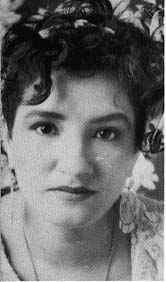
Hear Cisneros read from Caramelo
(6 minute audio)
Representative Text: Sandra Cisneros's Caramelo (2002)
"I'm trying to write the stories that haven't been
written. I feel like a cartographer; I'm determined to fill a literary void,"
Cisneros says . . . . Born in Chicago in 1954, Cisneros grew up in a family
of six brothers and a father, or "seven fathers," as she puts it. She recalls
spending much of her early childhood moving from place to place. Because
her paternal grandmother was so attached to her favorite son, the Cisneros
family returned to Mexico City "like the tides." "The moving back and
forth, the new schools, were very upsetting to me as a child. They caused
me to be very introverted and shy. I do not remember making friends easily,
and I was terribly self-conscious . . . . I retreated inside myself." It
was that "retreat" that transformed Cisneros into an observer, a role she
feels she still plays today.
--from
"Sandra Cisneros: Conveying the riches of the Latin American culture"

read first
read second
Interview From the September/October 2002 issue of Book magazine
Then Read the Novel
Caramelo has 86 short chapters and a Fin
Read through Chapter 50 to page 299 for Tuesday
Please Submit Topics and Questions You Would Like to Discuss In Class
Finish the novel for Thursday
Please Submit Topics and Questions You Would Like to Discuss In Class
Interview From the September/October 2002 issue of Book magazine
Then Read the Novel
Caramelo has 86 short chapters and a Fin
Read through Chapter 50 to page 299 for Tuesday
Please Submit Topics and Questions You Would Like to Discuss In Class
Finish the novel for Thursday
Please Submit Topics and Questions You Would Like to Discuss In Class